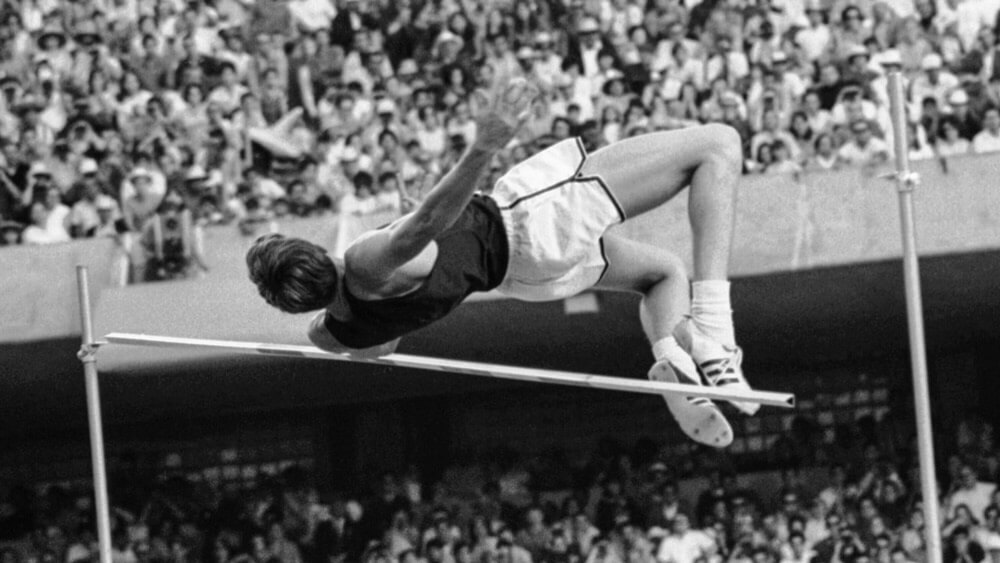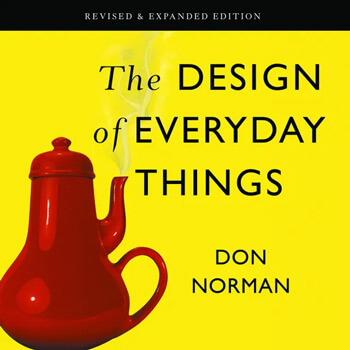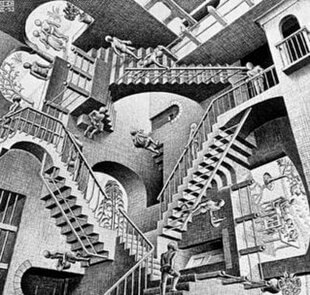Why Your Best Ideas Come From Asking Dumber Questions

In 1968, Dick Fosbury asked the stupidest question imaginable: "What if I jump backward?"
Every coach knew you went over face-first. That's just how high jumping worked. Fosbury's technique looked so ridiculous his own coach told him he'd never succeed.
He won the gold medal. Within a decade, every elite high jumper in the world jumped backward. Today, if you don't use the Fosbury Flop, you don't compete.
The question wasn't sophisticated. It was almost childlike: "Why does everyone do it that way?"
That's the secret nobody tells you about innovation. We've been sold this idea that breakthroughs come from brilliant minds having strokes of genius. But look at actual innovations and you'll find something different.
The best ideas come from someone willing to ask the obvious question everyone else stopped asking. The question that sounds too simple, too naive, too dumb.
"Why mail DVDs when we could stream them?" "Why hotels when there are empty rooms everywhere?" "Why did bacteria die around that mold?"
These aren't sophisticated questions. They're the kind that make experts roll their eyes. And that's exactly why they work.
We spend our lives getting smarter, accumulating knowledge, learning the "right" way to think. Somewhere in that process, we stop asking basic questions. We accept inherited assumptions. We follow established patterns because that's how things are done.
But here's what happens when you're willing to sound stupid: you see things everyone else trained themselves not to see. You find doors everyone else thinks are walls. You solve problems by realizing you're solving the wrong problem.
Let me show you what I mean.
 The Business Pivot: When Convention Becomes the Cage
The Business Pivot: When Convention Becomes the Cage
In the late 2000s, Netflix was the DVD-by-mail king. They'd perfected the logistics, the algorithms, the little red envelopes. Everyone in the industry was asking the same question: "How do we deliver DVDs better? Faster? Cheaper?"
But Netflix asked a different question: "What does our customer actually want?"
The answer wasn't better DVD delivery. It was instant gratification. The ability to watch something right now, without waiting, without planning ahead. Once they reframed the question, the solution became obvious—streaming. They weren't in the shipping business. They were in the entertainment-on-demand business.
That perceptual shift saved the company. More importantly, it created an entirely new category that would eventually subsume the old one.
Or consider Airbnb's founding insight. In 2007, Brian Chesky and Joe Gebbia couldn't afford their San Francisco rent. The conventional view of lodging was simple: if you need a place to stay, you book a hotel. That's just how it works.
But they looked sideways and saw something else: millions of empty rooms sitting in people's homes, unused. The problem wasn't a shortage of space—it was the absence of a platform that could connect travelers with those spaces and build enough trust to make the transaction feel safe.
They weren't solving a lodging problem. They were solving a trust and connection problem. Today, Airbnb has more rooms than all major hotel chains combined, and they don't own a single property.
The pattern repeats across every industry. The innovations that matter don't come from doing the same thing slightly better. They come from reframing what problem you're actually solving.
Athletic Breakthroughs: The Body Knows More Than One Way
For decades, high jumpers used the same basic techniques—the scissors kick, the straddle. Athletes refined these methods, became incrementally better, shaved off fractions of inches. Everyone was running the same race, just trying to run it faster.
Then in 1968, Dick Fosbury showed up at the Olympics and jumped backward.
His coach had told him his technique was wrong. Experts said it wouldn't work. But Fosbury had asked a simple question: Why do we assume you have to go over face-first? What if you go backward and arch your back over the bar?
He won the gold medal. Within a decade, nearly every elite high jumper had adopted the "Fosbury Flop." Today, it's the only technique used at the Olympic level. An entire sport transformed because one person was willing to look ridiculous while exploring a different angle.
Or take baseball's "Moneyball" revolution. For a century, scouts evaluated players the same way—by watching them and using traditional statistics like batting average and RBIs. The Oakland A's, faced with a fraction of the budget of teams like the Yankees, asked: What if we're measuring the wrong things? What if the statistics everyone values are actually poor predictors of winning?
They started looking at on-base percentage, slugging percentage, and other overlooked metrics. They found undervalued players who didn't look like stars but who consistently contributed to wins. With one of the smallest budgets in baseball, they became one of the most successful teams.
The innovation wasn't in working harder or spending more. It was in questioning which measuring stick everyone else was using.
 Medical Miracles Through Mismatched Thinking
Medical Miracles Through Mismatched Thinking
In 1928, Alexander Fleming was studying bacterial cultures when he noticed something irritating: one of his petri dishes had been contaminated with mold. The conventional response would have been to curse his luck, toss the ruined experiment, and start over.
Instead, Fleming got curious. Why had the bacteria died around the mold? That question led to penicillin, which has saved hundreds of millions of lives. The innovation wasn't in the mold itself—it had been around forever. The innovation was in treating apparent failure as information worth investigating.
Fast forward to 1956. Wilson Greatbatch was trying to build a device to record irregular heartbeats. He reached into his box of parts and accidentally installed the wrong resistor. When he powered up the device, instead of recording rhythms, it produced them—a steady, rhythmic pulse.
Most people would have muttered "damn," pulled out the right resistor, and moved on. Greatbatch paused. He recognized that his failed recorder could be a successful pulse generator. That mistake became the implantable pacemaker, a device that has extended countless lives.
Medical history is full of these moments—breakthroughs that came not from methodically following the established playbook, but from someone willing to look at a failure, an accident, or a strange observation and ask "what if?"
Your life probably doesn't involve petri dishes or cardiac devices, but the principle applies everywhere: what you're calling a mistake might be information in disguise. The question is whether you're curious enough to look.
Scientific Discovery: Asking Different Questions
For centuries, people looked at maps and noticed that the coastlines of Africa and South America seemed to fit together like puzzle pieces. Most dismissed it as coincidence. After all, continents don't move.
In 1912, Alfred Wegener asked: What if they do? What if these continents were once connected and have drifted apart?
The scientific establishment ridiculed him. He was asking the "wrong" question—everyone knew continents were fixed. But Wegener kept looking at the evidence from his sideways angle, and eventually, the theory of plate tectonics emerged, revolutionizing geology.
Or consider CRISPR, the gene-editing technology that's transforming medicine. Scientists studying how bacteria defend themselves against viruses noticed that bacteria use a molecular system to cut up viral DNA. That's interesting bacterial biology, but not obviously revolutionary.
Then someone asked a different question: What if we could repurpose this bacterial immune system as a tool to edit any gene we want?
That perceptual shift—seeing a defense mechanism as a precision editing tool—opened up possibilities from curing genetic diseases to engineering drought-resistant crops. The innovation was recognizing that one context's solution could become another context's revolution.
Science progresses not just through hard work and experimentation, but through the willingness to ask questions that sound naive or impossible. Often the breakthrough comes from someone who doesn't know enough to realize their question is "wrong."
 Art and Culture: Making the Familiar Strange
Art and Culture: Making the Familiar Strange
At the turn of the 20th century, Western art followed a clear rule: paintings should represent subjects from a single, fixed perspective—the way a human eye sees things. That's just what art is.
Then Picasso and Braque asked: What if we showed an object from multiple angles simultaneously? What if we broke the rules of perspective entirely?
The result was Cubism, and it didn't just create a new art style—it changed how we think about visual representation, truth, and dimensionality. They made the familiar strange, and in doing so, revealed new ways of seeing.
Jump forward to 2015. Lin-Manuel Miranda was thinking about how to tell the story of Alexander Hamilton. The traditional approach would be a straight biographical play, perhaps with classical music befitting the founding fathers' era.
Miranda asked: What if we tell this story through hip-hop and R&B? What if we cast it with primarily Black and Latino actors to emphasize that America then was about immigrants writing their story, just as America now is about immigrants and people of color writing theirs?
The match of revolutionary content with revolutionary form created Hamilton, one of the most successful and culturally significant musicals in history. Miranda didn't work harder at writing a traditional musical. He reframed what a musical about the founding fathers could be.
Or think about Banksy, the anonymous street artist. The art world had clear rules: art belongs in galleries, it's sold to collectors, it appreciates in value in a predictable market. That's the system.
Banksy looked sideways and made public spaces his gallery. He made art that couldn't easily be bought or sold, that belonged to everyone passing by. He used the street itself to comment on consumerism, war, and social issues—subverting the commercialization of art by making it uncommercializable.
These artists didn't succeed by being marginally more skilled than their peers. They succeeded by questioning assumptions about what was possible or appropriate in their medium.
Personal Life Hacks: Your Daily Perceptual Shifts
You don't need to revolutionize an industry or invent a new art form to benefit from sideways thinking. The same principles work in your daily life, often with immediate results.
Take time management. Most of us ask: "How do I fit everything in? How can I be more productive?" We buy planners, try new apps, wake up earlier, optimize our routines. And still we feel overwhelmed.
The lateral question is: "What if I'm asking the wrong things of my time? What should I stop doing?" Instead of addition, what about subtraction? When you reframe from "how do I do more" to "what deserves my attention," different answers emerge. Maybe the innovation isn't a better system for handling email—it's sending fewer emails in the first place.
Or consider career transitions. The standard approach is: "I need to find the right job. What's available? Where do I fit?" You scan job boards, tailor your resume, try to match yourself to existing boxes.
The sideways look asks: "What if I design a role that doesn't exist yet? What value could I create that no one is currently asking for?" Some of the most satisfying careers are carved out, not found. The innovation is recognizing you can create the slot rather than fill one.
Even relationship conflicts benefit from perceptual shifts. When you're arguing with a partner, colleague, or friend, the default question is: "How do I win this argument? How do I make them see I'm right?"
The lateral question is: "What if we're both solving different problems? What problem are they actually trying to solve?" Often what looks like opposition is just misaligned priorities. Reframing from "me versus you" to "us versus the problem" changes everything.
Learning new skills follows the same pattern. We typically think: I need to take a class, follow a curriculum, progress linearly from beginner to intermediate to advanced. That works, but it's not the only way.
What if you learned Spanish by changing your phone's language to Spanish? What if you learned photography by limiting yourself to one lens for a month? Sometimes the innovation is in the constraint, not the addition of more resources.
These aren't exotic techniques. They're available to you right now, in whatever situation you're facing. The question is whether you're willing to step back and look at it differently.
 The Meta-Skill: Training Yourself to See Sideways
The Meta-Skill: Training Yourself to See Sideways
The good news is that perceptual shift isn't just something that happens to lucky people. It's a skill you can develop. Here are four techniques that train your brain to look sideways:
Constraint Removal: Make a list of all the rules you're following in a given situation. Then ask of each one: "Is this actually a rule, or just a habit?" Most constraints are inherited, not inherent. The business has always been done this way. This is how people in my family approach this situation. My industry doesn't do that. Question them.
Perspective Multiplication: Deliberately inhabit different viewpoints. How would a complete beginner see this problem? How would an expert from a different field approach it? How would my competitor think about this? How would a customer experience this? The goal isn't to find the "right" perspective, but to collect multiple angles that reveal what you're missing from your default view.
Question Inversion: Flip your question. Instead of "How do I succeed at this?" ask "How would I guarantee failure?" Instead of "What should I do?" ask "What should I stop doing?" Instead of "How do I get people to like this idea?" ask "What would make people hate this idea?" Inversion often reveals hidden assumptions.
Cross-Domain Pollination: Look for solutions in unrelated fields. How do restaurants handle this kind of problem? What can I learn from how evolution solves challenges? How do video games keep people engaged? Many of the best innovations come from borrowing a solution from one domain and applying it to another.
The common thread in all these techniques is discomfort. Seeing sideways means temporarily giving up the efficiency and certainty of your usual perspective. It means being willing to look foolish while you explore an angle that might not work. It means staying curious when your brain wants to snap back to familiar patterns.
But that discomfort is where possibility lives.
Innovation as Practiced Curiosity
Here's what innovation actually is: it's practiced curiosity. It's the habit of interrogating your assumptions. It's recognizing that when you're stuck, you're probably asking the wrong question—not because you're dumb, but because the question you inherited doesn't serve the problem you face.
The most valuable innovations often look obvious in hindsight. Of course you'd jump backward over a high bar. Of course you'd stream movies instead of mailing DVDs. Of course you'd use a bacterial defense system to edit genes. But they only look obvious after someone was brave enough to question what everyone else accepted as given.
You don't need a revolutionary idea to benefit from this. You just need to pick one area of your life—your work, your relationships, your health, your learning—and ask: "What am I not seeing? What question am I not asking? What if I looked at this from a completely different angle?"
The world doesn't need more people doing the same things harder. It needs more people willing to step back, look sideways, and discover the door that's been there all along.
What will you see when you start looking? Visit: SedonaInnovationSummit.com

 The Business Pivot: When Convention Becomes the Cage
The Business Pivot: When Convention Becomes the Cage Medical Miracles Through Mismatched Thinking
Medical Miracles Through Mismatched Thinking Art and Culture: Making the Familiar Strange
Art and Culture: Making the Familiar Strange The Meta-Skill: Training Yourself to See Sideways
The Meta-Skill: Training Yourself to See Sideways